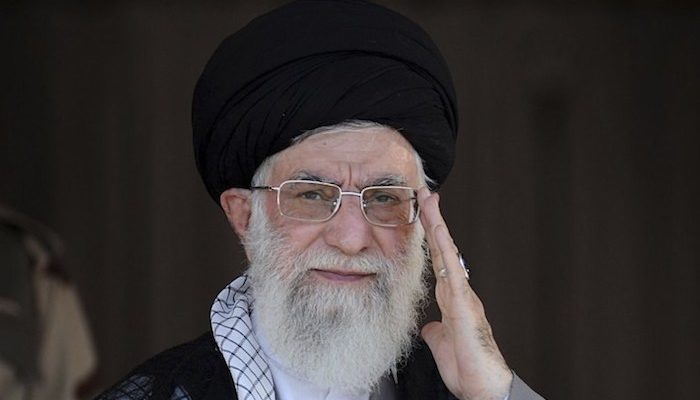Iran’s Ambitions, and Their Limits

In this picture released by an official website of the office of the Iranian supreme leader, Supreme Leader Ayatollah Ali Khamenei, center, attends a graduation ceremony of army cadets, in Tehran, Iran, Saturday, Oct. 5 2013. Iran’s top leader hinted Saturday that he disapproved of the phone call between Presidents Hassan Rouhani and Barack Obama during the Iranian leader’s trip to New York last month, but he reiterated his crucial support for the president’s policy of outreach to the West. (AP Photo/Office of the Iranian Supreme Leader)
By
Benjamin Kerstein several years ago found a number of parallels between the Nazi regime and present-day Iran. I agree with most, but not all, of his observations, which remain relevant and can be found here.
Imperialism: The Nazi regime’s primary short-term goal was to create a Europe-wide empire that would ensure the rule of the racially pure, annihilate or enslave all other races, and eventually lead to world domination. The Iranian regime’s goals are strikingly similar. It is now engaged in an imperialist policy intended to establish Iran as the hegemonic power in the Middle East; indeed, it often brags that it controls “four Arab capitals” — Beirut, Baghdad, Damascus and Saana. Should Iran succeed, it is highly likely that it will pursue expansionist aims well beyond its borders.
Here I beg to differ with Kerstein. It is true that for the Nazis the entire world was eventually to be conquered – “today Germany, tomorrow the world” – but not true that Iran harbors the same ambitions. It has regional ambitions – to create a Shi’a crescent from the Gulf to the Mediterranean. This is to be accomplished by using proxies and allies, because Iran itself – unlike Nazi Germany — is unable to project its own military power much beyond its borders. Thus Iran provides weapons and financial support to the Shi’a Houthis in Yemen, to the Kata’ib Hezbollah militias in Iraq, to the Alawite-led army (the Alawites are Shi’a) of Bashar Assad in Syria, and to Hezbollah in Lebanon; these are projectors and vectors of Iranian power.
But even with that limited ambition, Iran is meeting with serious resistance. The Saudis have impeded a total Houthi takeover of Yemen. In Iraq, the Sunnis naturally oppose those Shi’a militias that are allied to Iran. So, too, do many Iraqi Shi’a who are loyal to their nation and oppose Iran’s theocracy, which has not managed to extend its control in Iraq, and since the assassination of Qassem Soleimani in January 2020, the IRGC forces in Iraq have even pulled back. If Iran in the early days of the Islamic Republic was counting on Iraq’s Shia to join them, they were soon disabused of that notion. During the eight-year Iran-Iraq War (1980-88), there were no defections by Iraqi Shi’a to Iran’s side; they fought without complaint in Saddam Hussein’s war of aggression against Iran. And today, most of the Shia in southern Iraq — with the exception of the Kata’ib Hezbollah — find the Islamic Republic distinctly repellent. In Syria, meanwhile, Iran has spent $30 billion to help Bashar Assad in his civil war, but even now he controls only 75% of Syrian territory. And Iranian bases in Syria are routinely bombed by Israeli planes that destroy those bases as fast as Iran can build them. Iran’s investment in Syria has so far not paid off.
In Lebanon itself, Iranian ally Hezbollah has made itself unpopular for its hiding of weapons in civilian areas, which will necessarily be targeted by Israel if the looming war breaks out, as well as for threatening to drag Lebanon into a war with Israel that the Lebanese do not want, and for being responsible for the Beirut blast that killed 200, wounded 7,000, caused 300,000 Lebanese to be homeless, and resulted in $15 billion in damages. Hezbollah has reached the nadir of its support in Lebanon.
All of this shows just how weak Iran has turned out to be, compared to the Nazis who conquered much of continental Europe by 1942. Iran is still holding on – only just – through its proxies and allies in Yemen, in southern Iraq, in Syria, and in Lebanon. Even that Shi’a crescent – small beer by Nazi standards of conquest, continues to elude it.
Reaction: Both Nazism and the Iranian regime are fundamentally reactionary forces. Their ultimate goal is to reimpose pre-modern values and destroy all liberal ideals — including democracy, self-government, equal rights, religious tolerance, the separation of religion and state, and the emancipation of women….
Yes, both the Nazis and the Iranian theocrats abhor the modern liberal state: democracy, self-government, equal rights for all. In the Nazi super-state, only Aryans were to rule. In the Iranian theocracy, only Muslims should rule. But there are differences. There is no religious tolerance in Iran for anything but Islam. The Nazis were willing to tolerate, and even make deals with, Catholics and Lutherans, as long as their faith did not get in the way of loyalty to the Third Reich. The Nazis were fundamentally against religions – the only true religion for them was their own savage creed — but they did not persecute Christian believers as long as those believes did not oppose Hitler’s regime. Those who did, such as Hans and Sophie Scholl of the White Rose, were relentless opponents of Hitler and were executed not for being Christians, but for being anti-Nazis.
There is no separation of religion and state in Iran because religion has swallowed up the state; in Nazi Germany, the state swallowed up religion. As for the claim that both Iran and the Nazis opposed the emancipation of women, that is not quite true. In Iran, the position of women worsened under Khomeini, because of the clear inferiority of women In Islam. A Muslim husband has a right to beat his wife if he merely suspects her of being disobedient; a woman’s testimony is worth half that of a man; a daughter ordinarily inherits half of what a son inherits. One of the first laws of Khomeini’s regime was to lower the marriageable age of girls to nine – the age of Aisha when she married the 54-year-old Muhammad. In Nazi Germany women were not regarded as inferior; they were fully emancipated. But the Nazis believed that ideally German women should privilege their roles as wives and, especially, as mothers, tasked with producing ever more Aryan children, in order to demographically strengthen the Third Reich.
If this is a new Nazism, a theo-Nazism no less threatening to the world than its predecessor, it seems clear that there is only one thing to do: work toward its destruction….
Here I beg to differ with Kerstein. I don’t think any military analyst would agree that Iran is “no less threatening to the world than its predecessor,” Nazi Germany. It’s “threatening.” Not as “threatening” as Nazi Germany was in 1942. Not nearly as “threatening” as China or Russia or North Korea are today to our peace and security, but indeed deeply “threatening.” Isn’t that enough?
















